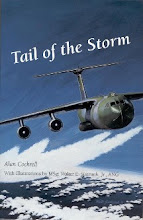 In January our chief pilot decided to clean house. Her target: The bag
room. It's a huge repository—probably 3,000 square feet or more—for pilots to
store their bags, sundries and paraphernalia when off duty. The interior is
walled into separate long corridors with multiple layers of shelves along each
side. The shelves are home to layover bags, duffels, pubs bags, storage bags,
boxes, back packs and hang-up bags of all sorts and sizes in which commuting pilots and even some
locals store their extra stuff.
In January our chief pilot decided to clean house. Her target: The bag
room. It's a huge repository—probably 3,000 square feet or more—for pilots to
store their bags, sundries and paraphernalia when off duty. The interior is
walled into separate long corridors with multiple layers of shelves along each
side. The shelves are home to layover bags, duffels, pubs bags, storage bags,
boxes, back packs and hang-up bags of all sorts and sizes in which commuting pilots and even some
locals store their extra stuff. My layover bag resides there. I rarely drag it home. I keep layover
clothes, toiletry kit and other items in it that don't need to regularly go
home. That lets me make the commute to and from work with only a small back
pack that I don't have to gate check on those oh-my-aching-ass 50-seaters. I
once figured that the 10 minutes I spend waiting for my gate-check bag to be
retrieved—twice for each round trip commute—added up to 25 hours in a year's
time. A full day out of my life every year standing on
that lousy noisy hot/cold jet bridge. But now, with my nifty system, I
breeze off the Rjs like a bat out of a cave.
My layover bag resides there. I rarely drag it home. I keep layover
clothes, toiletry kit and other items in it that don't need to regularly go
home. That lets me make the commute to and from work with only a small back
pack that I don't have to gate check on those oh-my-aching-ass 50-seaters. I
once figured that the 10 minutes I spend waiting for my gate-check bag to be
retrieved—twice for each round trip commute—added up to 25 hours in a year's
time. A full day out of my life every year standing on
that lousy noisy hot/cold jet bridge. But now, with my nifty system, I
breeze off the Rjs like a bat out of a cave. But back to the bag room. The room is so expansive you can lose your
bags if don't take careful notice where you left them. It's common to see a
pilot wandering through the complex scanning with wrinkled brow, looking for
his stuff. During the first five minutes of his search, he will draw at least
two “It's the black
But back to the bag room. The room is so expansive you can lose your
bags if don't take careful notice where you left them. It's common to see a
pilot wandering through the complex scanning with wrinkled brow, looking for
his stuff. During the first five minutes of his search, he will draw at least
two “It's the black
At first it's interesting to stroll through the halls looking at the
stickers and decals:
 military units, ball clubs, flags, college letters and
logos from other airlines the owner may have flown with. But after months and
years looking at the stickers you tire of their sight. They remind you of the
huge chunk of your life you're spending away from family and dog.
military units, ball clubs, flags, college letters and
logos from other airlines the owner may have flown with. But after months and
years looking at the stickers you tire of their sight. They remind you of the
huge chunk of your life you're spending away from family and dog.The place is dusty, musty, dimly lit and even at times a bit spooky. It's easy to imagine the ghosts of pilots who passed through those corridors hundreds of times across a career. Some now retired. Some gone west.
When our chief pilot planned the clean-out she had her staff place an
orange dot sticker on every flight bag, layover bag, hang-up bag, and
container of any sort. She told us we had 60 days to take the dot off. After
that she would consider all dotted bags and items abandoned and would dispose
of them.
I was there the day she and her staff collected their bounty. The
amount of abandoned bags staggered the imagination. They were piled high in
every place available and then the long process began of going through the
contents. They sorted items for trash and charity. She told us what they found
in her monthly newsletter. Here's a sampling:
- A vintage leather flight bag in mint condition with original manuals, last revised 1987.
- Complete newspapers from 20 years ago in unread condition.
- A VCR with a pile of movies from the1980s.
- Bags of long ago retired and deceased pilots.
- Medical certificates from the late 70s.
- Prescription medicines of many kinds, lots of them, some dating back to the 70s.
- Enough bottles of wine beer, and liquor to supply a tiki bar.
- Flight attendant bags.
- Flight manuals from long obsolete aircraft (747-100, DC-9, B727).
- Layover pictures from 30 years ago.
- Several “recreational items for personal entertainment.” [Hmmm.]
- A petrified banana.
But what?
 |
| I won't. |





Good read!
ReplyDeleteThis started off like a tale of typical management overreach of the newly promoted/unqualified (AA). But in the end it was something that probably needed to be done. Long overdue housekeeping and all that. Interesting, the stuff that has been lurking there all these years.
ReplyDeleteSounds like we're going out at the same time. 15 months. I can't wait.
ReplyDeleteE-mailed by Mike Murphy:
ReplyDeleteRJ? I thought you were flying 767/757? Do you also fly RJ's?
Nice article!
(o)^(o) (<- goggles)
\____/ Mike
Hello Mr Cockrell,
ReplyDeleteLovely to have a new post from you - are you back on the line yet?
If I were clearing out the bags it would take forever, I'd want to go through every old paper etc and reminisce...
Just a side note, I recently went on holiday (in a 767-300 LGW-MLE) a long flight! I took your book with me (Tail Of The Storm) and loved it - it gave me a great insight into the man whose blog I have come to enjoy immensely!
The flight crew were fantastic and I visited the flight deck on arrival and in spite of them probably wishing to get the heck out of there they were chatty and took a pic of me sitting in the FO's seat!
Keep up the great work with the blog!
With kind regards
Dave W
Thanks Dave. Glad you enjoyed the book and the trip. Good on those pilots who cut into their layover to let you visit the cockpit.
DeleteAviation Time capsules. Must a story in there somewhere.
ReplyDeleteSpeaking of old flight manuals, I have a question. In the '60s, I read that it required about 30 pounds of back pressure to rotate a commercial airliner for takeoff. How much back pressure is required of B757/B767s?
ReplyDeletewayne in louisiana
Wayne, I honestly don't know what 30 pounds of back pressure is supposed to fell like and I don't remember seeing any flight manual in which back pressure for rotation was expressed in pounds. Thirty seems heavy. The 757/767 flight manual only says use no more that 2 1/2 degrees per second to an attitude of 11 degrees for 767 and 12.5 degrees for 757. This is to avoid striking the tail. I think both planes feel about the same for rotation: slight, gentle back pressure. Roll though is another matter. The 757 roll pressure is heavy, while the 67 is light and sporty because of its 4 ailerons.
ReplyDelete